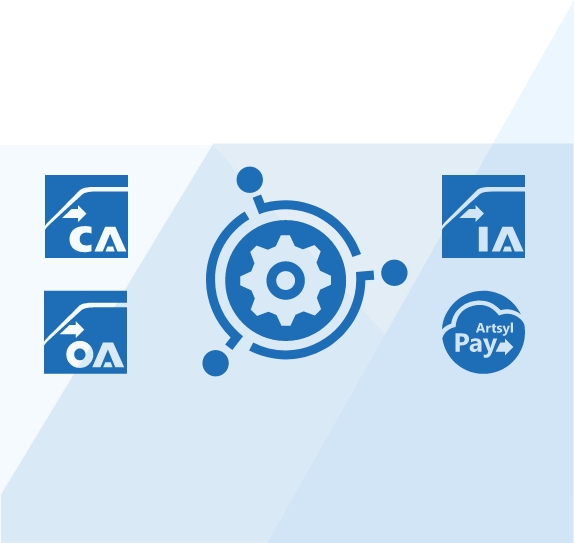Online transactions have become the norm for most businesses and consumers in today’s digital age. As a result, virtual credit cards have gained significant popularity as a secure and convenient payment method. Unlike traditional credit cards, virtual credit cards come with a unique card number that is only valid for a single transaction and expires immediately after use. In this blog post, we’ll discuss the significance of virtual credit card adoption in today’s digital landscape and what matters for CFOs and financial controllers.

Upgrade your payment process with ArtsylPay!
Experience the convenience and security of accepting virtual credit cards. Streamline your accounts receivable, eliminate manual data entry, and enjoy faster payments.
How Virtual Credit Cards Are Changing the Future of Payments
Virtual credit cards are revolutionizing the future of payments by offering enhanced security, convenience, and flexibility. With the growing digitization of financial transactions, virtual credit cards provide a secure alternative to traditional payment methods.
These virtual cards, generated for one-time use or limited periods, protect sensitive financial information by providing unique card numbers for each transaction. This mitigates the risk of fraud and unauthorized transactions, ensuring safer online shopping experiences. Moreover, the flexibility of virtual credit cards allows for seamless integration with digital wallets and mobile payment platforms, making transactions faster and more convenient.
As businesses and consumers increasingly prioritize security and convenience in their payment experiences, virtual credit cards are poised to play a significant role in shaping the future of payments recognized by CFO and financial controller alike.
Intelligent Process Automation Solution
Related Videos
Benefits of Virtual Credit Cards from CFO and Financial Controller’s Perspective
One of the most significant benefits of virtual credit cards is that they offer enhanced security measures compared to traditional credit cards. Virtual credit cards come with a unique card number, valid only for a single transaction, making it impossible for fraudsters to use the card for unauthorized transactions.
Additionally, virtual credit cards are issued with a pre-set spending limit, ensuring the user does not exceed their budget. This is especially important for financial controllers who are in charge of corporate budgets.
Discover the power of ArtsylPay’s virtual credit card acceptance. Simplify your payment collection process, reduce errors, and expedite cash flow. Maximize efficiency and focus on growing your business while ArtsylPay handles your payment needs.
Book a demo now
Convenience: Important for Users, Appreciated by CFOs and Financial Controllers
Virtual credit cards offer unmatched convenience to users, primarily because they are easily accessible through online banking portals or mobile apps. Unlike traditional credit cards, virtual credit cards can be created and used instantly, allowing users to make transactions without delays.
Furthermore, virtual credit cards eliminate the need for physical cards and reduce the risk of card loss or theft, which is vitally important for anyone who manages corporate finance.
Cost Savings: Treasured by Financial Controllers and CFOs Alike
Virtual credit cards significantly help businesses reduce their payment processing costs. Because virtual credit cards come with lower processing fees, businesses can save substantial money on transaction fees — another feature that cannot leave CFOs unimpressed.
Additionally, CFOs noticed businesses could save on paper, postage, and administrative costs associated with traditional payment methods, which are nonexistent with virtual credit cards.
Global Acceptance: Important for Global CFOs
Virtual credit cards are widely accepted worldwide across all major e-commerce platforms and digital marketplaces. They allow businesses to engage in cross-border transactions seamlessly, eliminating the need for cumbersome processes and multiple cards.
As a result, globally-minded businesses can expand their customer base and reach new markets by adopting virtual credit cards.
Fraud Prevention: Vital for Financial Controllers
Virtual credit cards are also helpful in preventing fraud and chargebacks, which are common issues in online transactions. Virtual credit cards provide an additional layer of security against fraudulent transactions that can result in revenue loss for businesses.
Join the digital revolution in payment processing! ArtsylPay offers seamless integration for processing virtual credit card payments. Enjoy the benefits of instant payment verification, enhanced security, and improved reconciliation.
Book a demo now
Factors to Consider for Virtual Credit Card Adoption
When considering the adoption of virtual credit cards, there are several factors to take into account. These factors can help guide individuals and businesses in making informed decisions regarding the use of virtual credit cards. Here are some key considerations:
- Security: One of the primary factors to consider is the security measures offered by the virtual credit card provider. CFOs and financial controllers should ensure that the provider implements strong encryption and authentication protocols to protect sensitive payment information.
Look for features such as tokenization, two-factor authentication, and fraud detection systems to minimize the risk of unauthorized access and fraudulent transactions. - Acceptance: Verify the acceptance of virtual credit cards by the merchants or service providers you frequently transact with. While virtual credit cards are becoming more widely accepted, confirming that the payment method is supported by the platforms you intend to use is essential.
CFO and financial controller should check if the virtual credit card can be used for online purchases, subscriptions, or other transactions employees frequently engage in. - Convenience and Integration: Assess the ease of use and integration of virtual credit cards with your existing payment systems or financial management tools. CFO and financial controller should consider whether the virtual credit card provider offers mobile apps, web interfaces, or API integrations that align with your preferences and requirements.
Seamless integration with the business financial ecosystem can streamline payment processes and enhance overall convenience. - Fees and Costs: During virtual credit card adoption, evaluate the fee structure associated with virtual credit cards. Some providers may charge card issuance, transaction, or account maintenance fees. Compare the costs across different providers to determine the most cost-effective option for your needs.
Additionally, consider any potential savings or benefits offered, such as cashback rewards or discounts, which can offset the fees. - Limitations and Restrictions: Understand any limitations or restrictions virtual credit card providers impose. This can include maximum transaction amounts, expiration dates, or specific usage restrictions. CFOs and financial controllers should assess whether these limitations align with your intended usage and ensure they do not hinder your ability to make necessary transactions.
- Reporting and Control: CFO and financial controller together should consider virtual credit card providers’ reporting and control features. Look for options that allow you to monitor and track transactions, set spending limits, and generate detailed reports for accounting and reconciliation purposes. These features can be particularly valuable for businesses seeking better expense management and financial oversight.
- Customer Support: Financial controllers must evaluate the customer support services offered by virtual credit card providers. In the event of any issues or concerns, prompt and reliable customer support can be crucial. To ensure virtual credit card adoption, look for providers that offer accessible support channels, such as phone, email, or live chat, to address any queries or resolve problems efficiently.
By carefully considering these factors, individuals and businesses can assess the suitability of virtual credit card adoption and choose a provider that best aligns with their security requirements, convenience, and financial goals.
Ready to streamline your payment operations? ArtsylPay is here to help! Accept virtual credit cards effortlessly and transform your accounts receivable process. Say goodbye to manual data entry and hello to automated payment reconciliation with ArtsylPay.
Book a demo now
Potential Barriers to Virtual Credit Card Adoption
While virtual credit cards offer numerous benefits, there are also potential barriers that may hinder their widespread adoption. It’s essential to be aware of these barriers when considering implementing virtual credit cards. Here are some potential challenges to consider:
Merchant Acceptance
One of the key barriers to virtual credit card adoption is the limited acceptance by merchants. Not all online vendors or service providers may support virtual credit card payments, which can restrict the usability of these cards. Lack of acceptance can be a significant obstacle, especially for individuals or businesses that frequently transact with specific merchants or industries that have not fully embraced virtual credit cards.
User Familiarity and Comfort
Virtual credit cards are a relatively new concept, and some individuals may be hesitant to adopt this technology due to a lack of familiarity or comfort. Traditional credit cards have a long-established presence and widespread usage, making it challenging for virtual credit cards to compete for acceptance and trust. Overcoming this barrier requires education and awareness campaigns to familiarize users with virtual credit cards’ benefits and security features.
Technological Infrastructure
The successful adoption of virtual credit cards relies on a robust technological infrastructure. Both card issuers and merchants need to have secure systems in place to support virtual credit card transactions. In regions with limited technological advancements or outdated payment systems, the infrastructure may not be fully equipped to handle virtual credit card transactions, creating a barrier to adoption.
Regulatory Environment
The regulatory environment surrounding virtual credit cards can vary across different jurisdictions. Compliance with regulations and ensuring consumer data protection can be complex and challenging for virtual credit card providers. Stringent regulations or ambiguous legal frameworks can discourage providers from offering virtual credit cards in certain regions, limiting their availability and adoption.
Security Concerns
While virtual credit cards offer enhanced security features, some individuals may still be concerned about their payment information’s security. Cybersecurity threats, data breaches, and identity theft are ongoing risks in the digital landscape. Addressing these concerns by implementing strong security measures and educating users about the safety features of virtual credit cards is crucial for broader adoption.
Limited Features and Benefits
Traditional credit cards often come with a range of additional features and benefits, such as rewards programs, cashback offers, or travel perks. Virtual credit cards may have fewer or different types of benefits, which can make them less appealing to individuals who value these additional incentives. Virtual credit card providers must explore innovative ways to offer compelling features and benefits to attract users.
Integration Challenges
Integrating virtual credit cards into existing financial systems or payment platforms can pose technical challenges. Compatibility issues or difficulties syncing virtual credit card transactions with accounting software or expense management systems may deter businesses from adopting virtual credit cards.
By recognizing these potential barriers and actively addressing them, virtual credit card providers can work towards overcoming these challenges and drive broader adoption of this modern payment solution.
With ArtsylPay, you’ll enjoy faster, more secure transactions and simplified virtual credit card payments. Don’t miss out on this opportunity — upgrade your payment
system with ArtsylPay now!
Book a demo now
Case Studies and Success Stories of Virtual Credit Card Adoption
These case studies highlight the successful implementation of virtual credit cards across various industries, showcasing the benefits of increased efficiency, cost savings, enhanced security, and improved financial control.
Case Study 1
A medium-sized e-commerce retailer integrated virtual credit cards into its online payment system to enhance customer convenience and reduce transaction risks. They saw increased sales and conversion rates by offering virtual credit cards as a payment option.
Customers appreciated the added layer of security and the ability to use virtual cards for one-time purchases without sharing their sensitive payment information. The successful implementation of virtual credit cards helped the company gain a competitive edge and build trust with its customer base.
Case Study 2
A multinational corporation leveraged virtual credit cards for travel and expense management. By providing virtual cards to employees for business travel expenses, they simplified the reimbursement process and improved control over spending.
The company experienced faster expense reporting and reduced paperwork, increasing productivity and cost savings. The detailed transaction data provided by virtual credit cards allowed for better tracking and analysis of travel expenses, enabling the company to optimize its travel budget.
Case Study 3
A healthcare organization adopted virtual credit cards for supplier payments in their accounts payable department. This enabled them to centralize their payment processes and streamline vendor payments. The use of virtual credit cards simplified the reconciliation process and reduced the time spent on manual invoice matching.
Additionally, the enhanced security features of virtual credit cards helped mitigate the risk of fraudulent activities. The company reported improved cash flow management and strengthened vendor relationships through timely and secure payments.
These success stories demonstrate the potential of virtual credit card adoption to transform payment processes and drive positive outcomes for businesses of different sizes and sectors.
Final Thoughts
As businesses continue to navigate the changing payment landscape, virtual credit cards provide a secure, convenient, and cost-effective solution for online transactions.
With enhanced security measures, convenience, cost savings, global acceptance, and fraud prevention capabilities, virtual credit cards have become essential for businesses and consumers to succeed in today’s digital age.
Whether you’re a small business owner or a frequent online shopper, virtual credit cards offer unparalleled benefits and are here to stay.
Maximize operational efficiency and customer satisfaction by accepting virtual credit cards with ArtsylPay. Seamlessly integrate ArtsylPay into your existing systems and enjoy the benefits of real-time payment verification and streamlined reconciliation.
Book a demo now




 Payment Processing: Security, Compliance, and Fraud Prevention
Payment Processing: Security, Compliance, and Fraud Prevention ACH Payments and Transfers: The Ins and Outs
ACH Payments and Transfers: The Ins and Outs How to Use OCR Software for PDFs and Other File Formats
How to Use OCR Software for PDFs and Other File Formats Accounts Payable Best Practices that’ll get you through a Tough Economy
Accounts Payable Best Practices that’ll get you through a Tough Economy Smart Procurement & Payments Processing
Smart Procurement & Payments Processing Exploring Cutting-Edge Payment Solutions: Comparison of Payment Processing Platforms
Exploring Cutting-Edge Payment Solutions: Comparison of Payment Processing Platforms